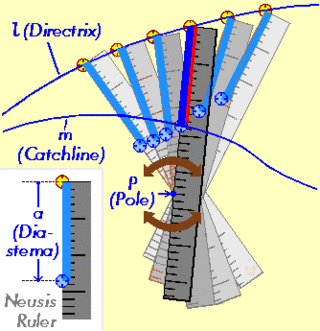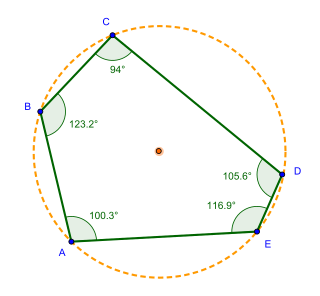Regular icositrigon
A regular icositrigon is represented by Schläfli symbol {23}.
A regular icositrigon has internal angles of  degrees, with an area of
degrees, with an area of  where
where  is side length and
is side length and  is the inradius, or apothem.
is the inradius, or apothem.
The regular icositrigon is not constructible with a compass and straightedge or angle trisection, [1] on account of the number 23 being neither a Fermat nor Pierpont prime. In addition, the regular icositrigon is the smallest regular polygon that is not constructible even with neusis.
Concerning the nonconstructability of the regular icositrigon, A. Baragar (2002) showed it is not possible to construct a regular 23-gon using only a compass and twice-notched straightedge by demonstrating that every point constructible with said method lies in a tower of fields over  such that
such that  , being a sequence of nested fields in which the degree of the extension at each step is 2, 3, 5, or 6.
, being a sequence of nested fields in which the degree of the extension at each step is 2, 3, 5, or 6.
Suppose  in
in  is constructible using a compass and twice-notched straightedge. Then
is constructible using a compass and twice-notched straightedge. Then  belongs to a field
belongs to a field  that lies in a tower of fields
that lies in a tower of fields  for which the index
for which the index  at each step is 2, 3, 5, or 6. In particular, if
at each step is 2, 3, 5, or 6. In particular, if  , then the only primes dividing
, then the only primes dividing  are 2, 3, and 5. (Theorem 5.1)
are 2, 3, and 5. (Theorem 5.1)
If we can construct the regular p-gon, then we can construct  , which is the root of an irreducible polynomial of degree
, which is the root of an irreducible polynomial of degree  . By Theorem 5.1,
. By Theorem 5.1,  lies in a field
lies in a field  of degree
of degree  over
over  , where the only primes that divide
, where the only primes that divide  are 2, 3, and 5. But
are 2, 3, and 5. But  is a subfield of
is a subfield of  , so
, so  divides
divides  . In particular, for
. In particular, for  ,
,  must be divisible by 11, and for
must be divisible by 11, and for  , N must be divisible by 7. [2]
, N must be divisible by 7. [2]
This result establishes, considering prime-power regular polygons less than the 100-gon, that it is impossible to construct the 23-, 29-, 43-, 47-, 49-, 53-, 59-, 67-, 71-, 79-, 83-, and 89-gons with neusis. But it is not strong enough to decide the cases of the 11-, 25-, 31-, 41-, and 61-gons. Elliot Benjamin and Chip Snyder discovered in 2014 that the regular hendecagon (11-gon) is neusis constructible; the remaining cases are still open. [3]
An icositrigon is not origami constructible either, because 23 is not a Pierpont prime, nor a power of two or three. [4] It can be constructed using the quadratrix of Hippias, Archimedean spiral, and other auxiliary curves; yet this is true for all regular polygons. [5]







































